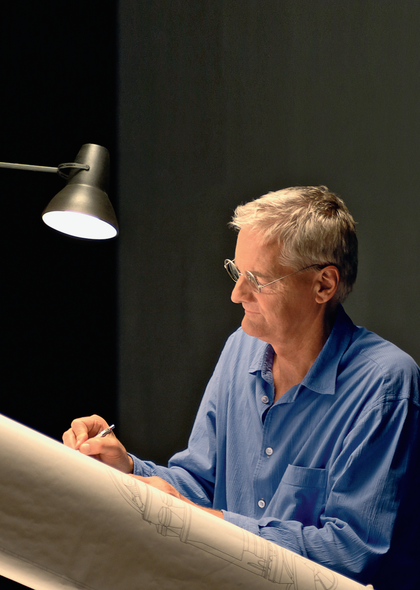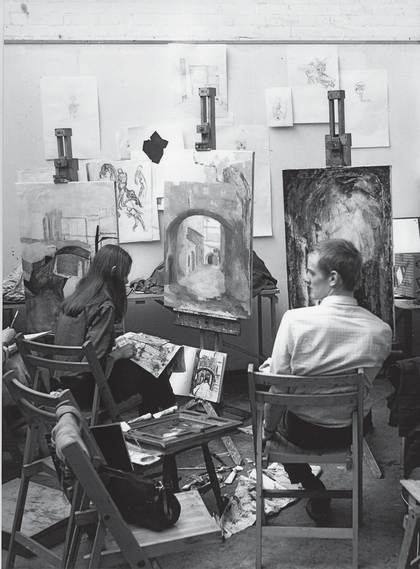
James Dyson working at his drawing board
© Dyson Ltd, courtesy James Dyson Foundation
I was just eight or nine years old when I began painting, and my passion for the subject only grew with age. But in those days, art was not something that commanded a great deal of respect.
Since my father had been the classics master at my school, Gresham’s, and my brother a classics scholar, my studies were preordained – and my artistic endeavours frowned upon. My attempt to add an edge to the design of the flyers for our house play, Sheridan’s The Critic, by doing them as scrolls rather than folded A4 paper, was met with disdain by my housemaster. ‘Programmes, Dyson,’ he intoned, ‘should be flat!’
The ex-RAF, handlebar-moustachioed careers officer tried to tell me that my love of the great outdoors meant that I would be well suited to a career as an estate agent. Failing that, he thought I might try medical school: the one thing he was clear that I should not do, was become an artist.
Advice is given to be ignored. I hadn’t the faintest notion of what my future would hold, but I knew that my passion was art and refused to be dissuaded. And so it was that in 1966 I found my way to the Byam Shaw School of Art in Kensington, under the watchful eye of principal Maurice de Sausmarez.

James Dyson and Deirdre Hindmarsh in the Byam Shaw painting studio, 1966
© David Noble 1966
I was immediately taken with Maurice. Not only was he a tremendously talented painter, but to the young and impressionable he had all the right friends – Peter Sedgley and Bridget Riley, two of the most famous op artists of the time. But as I came to know him better, I learned that Maurice’s real genius was an uncanny ability to know what a person was good at, even if they themselves hadn’t an inkling.
It was Maurice who sat me down at the end of my year at Byam Shaw and forced me to think about the future. At that time, I wanted to be a painter. It had never occurred to me that there were other options open to me – and suddenly, there was Maurice telling me with enthusiasm that I should be a designer. I hadn’t the foggiest idea what a designer was. I was from a small village in Norfolk. But Maurice seemed to think I would have an aptitude. He reeled off fields of design – and among them was furniture. I had sat in a lot of chairs, and I’d broken and fixed them. So I figured, as you do at that age, that I could probably design them, too. And so off I went to the Royal College of Art – at the time exclusively a graduate school, but Maurice had discovered that it was running an experiment in anti-elitism and accepting three students in each intake without first degrees.
Maurice had a good deal more insight into my passions than I did. For the past 50 years I have practised as a designer and engineer on his instinct that I would have some talent!
Teachers have a great impact on the lives of young people. They shape the world view of students and help them to aspire to worthwhile ambitions. An inspiring teacher can set a student on the path to accomplishment, and endow them with the confidence to follow that path, be creative and take risks.

Maurice de Sausmarez outside the Byam Shaw School of Art with some of his students, 1965
Courtesy de Sausmarez Family Archive
Under Maurice’s guidance, I learned that I could love art without being restricted to the stringent perceptions of my schoolteachers. He gave me the courage to look into new, undiscovered disciplines and, in time, reunite the artist in me with the scientist. Thanks to Maurice, when I invented the DC01 vacuum cleaner, I had the conviction to concentrate on function first and understand that the engineering could be beautiful in itself.
I owe much of my career to Maurice’s unwavering belief that talent and enthusiasm will shine through – if you just open the right doors. I endeavour to take the same approach with the bright young minds at Dyson – where the average age is 26 – allowing them to make mistakes and learn from them, trusting that they will succeed. I know Maurice would approve.
